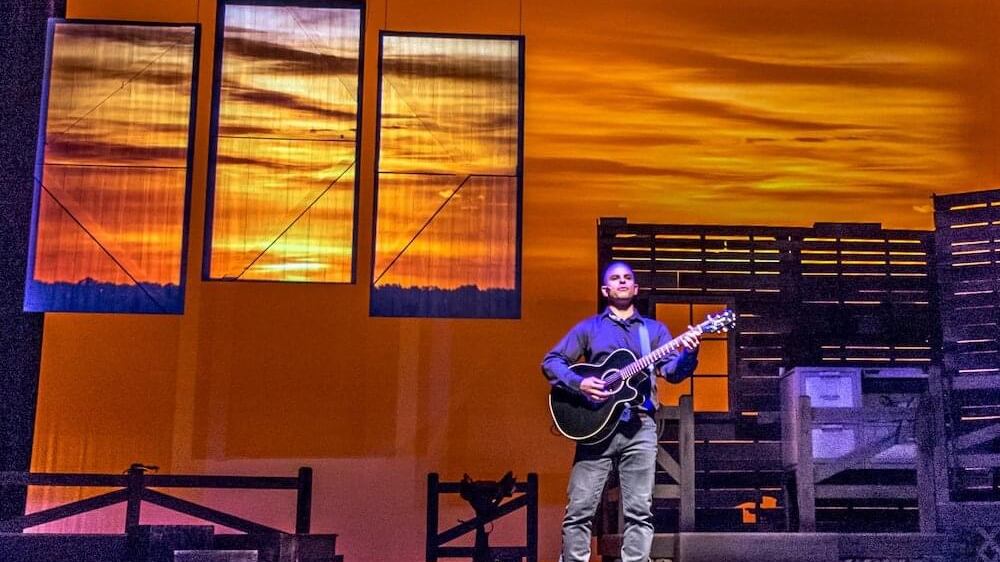Steve Coker always thought of himself as a “one-man band.” The local theater mainstay, currently helming Johnny Cash bioperetta Ring of Fire, grew to prominence by writing, directing, producing and often starring in a string of tongue-in-cheek adaptations (Xana-redU, Flash Ah-Ahhh!) and pan-genre parodies (Varsity Cheerleader Werewolves From Outer Space, The Adventures of Dex Dixon: Paranormal Dick!) under the StageWorks banner.
Recently, though, he’s become a central presence within Stumptown Stages’ eclectic series of musical comedies, winning Best Actor at the 2019 Portland Area Musical Theater Awards for his Urinetown performance.
Coker still plans on launching StageWorks’ Popeye live debut after COVID restrictions canceled its original run at the last moment and fulfilling the potential of his most popular character through additional platforms. (After touring conventions with a prototype Dex Dixon tabletop board game, he’s scheduled an autumn Kickstarter push to help fund production costs.) Still, he’s been Increasingly drawn to the comparative freedom these Stumptown collaborations allow.
After Ring of Fire opened to packed houses last weekend, WW sat down with the Oregon native to talk about the surprising ease with which Johnny Cash’s story can be told through music alone and the implicit challenges of evoking that legendary voice without descending into caricature.
WW: How different is this from the Broadway production?
Steve Coker: That was a pretty massive show—probably 25 or 30 people, maybe 40 Johnny songs—that took you from his birth all the way to June Carter’s death. Shortly after, they trimmed down to five or so performers for a shorter touring version. So, they don’t spend as much time with his first wife in this production as they did in the original, but there’s a few songs that take it from when he got famous through his divorce and touch upon how the musicians inadvertently hurt the people they love because they have to leave home. Walk the Line spent a lot of time with that, but this show really just highlights the bullet points of his rise to fame.
I remember some box set divided his best songs between Love, God and Murder discs. We’re focused squarely on love here?
Yeah, and some really beautiful gospel pieces, too, about the moment of loss when his brother passed. Johnny started out singing gospel music. It wasn’t until he tried to make a recording that he was told gospel didn’t sell and he should try writing love songs.
In the play, at that time, he comes out to a song called “Going to Memphis” about his time on a chain gang. He’d been in a bar fight and ended up in a correctional facility for a while. Although he said he never really spent time in penitentiaries, he had a kinship for them—an appreciation for the downtrodden and forgotten—and I think that experience influenced him to start writing about some of those things.
Is there a live band? Recordings? A mix?
There’s no other musical accompaniment besides the actors on stage. They all play their own instruments, and everything’s right out in the open. They walk out in the beginning with all the instruments hanging on the set. Terry [Kitagawa] plays bass guitar throughout the show. Hadley [Parrish-Cotton] plays harmonica and acoustic guitar. Illya [deTorres] plays acoustic guitar. And, then, we have our music director and all-over guy Adam [Young] on piano, mandolin, violin, electric guitar, acoustic….
What are the cast members’ backgrounds? Had any of them spent time playing music outside of the theater?
All five have a mixture of both, actually. That was imperative. We focused on finding people who had both abilities. They come from all over the place. Hadley, who does the female roles, started doing theater in Portland with the Star Trek musical improv show at Funhouse Lounge. Terry just moved here from New York City as probably more a musician than anything else, but he has experience acting as well.
Are they copying his sound?
No impressions, though Dustin [Fuentes] just has the real flavor of Johnny built into this great country voice. During the encore, they do a little of the caricature for “A Boy Named Sue,” but it’s kind of expected with that song. We don’t try and make the cast look like Johnny at all, you know. They’re just in costume—black shirt, black jeans, black dress. It came out really well, I think.

Who plays Johnny?
Interesting thing about that—none of the characters in the show are actually named after Johnny or the rest of those folks. In fact, the character of Johnny’s kind of split between two of the actors throughout the show. Basically, Illya and Dustin bounce back and forth to play him at different times, but Illya serves as the narrator of the show, which really only has about six monologues. There’s hardly any dialogue at all—almost no interaction with the audience via text. Telling the story through two hours of music with just a little bit of talking to transition between scenes, that was the challenge, but everything’s tight.
Illya and Dustin split the songs down the middle?
Fifty-fifty.
Any fights over who got what?
Oh, God, no. We gave “Delia” to Adam because of the way we were directing that moment, but the songs were assigned to the characters in the script. When you get a show from Broadway, you don’t really have much license to change anything. Since they’d already used “Hurt” on Broadway, we felt we didn’t have to ask before including it in our version. Outside that realm, you definitely need permission.
How’d you differentiate between the two?
For the most part, it just works organically. If, you know, the emotional beat was more appropriate for a father figure, then Illya would sing. He does all the talking for Johnny, so you can tell that he’s starting a story that leads into a scene where the younger guy picks up the dialogue.
And the audience follows along?
[The play] is, weirdly, kind of abstract, but there’s a connective tissue. Each vignette stands alone as a really great performance piece, and the emotional beats really carry it forward. Johnny wrote about himself and about the world around him, which obviously helped, and the people who put this show together really picked all the right songs that hit the right tones for telling the story of his life.
There’s something I realized once we started rehearsing Flash Ah-Ahhh! The trick with making shows like this work is finding songs that move the narrative forward without stopping the action as opposed to shoving familiar music into the storyline.
Our shows made fun of the dialogue, we make fun of the acting, but we always respect the music. In past performances, I’ve been true to the music above all else. That’s the thing here. The music is tight. There are a lot of a cappella moments, and the harmonies are gorgeous. It’s amazing how well these five performers blend together.

Given all your work with Stumptown, what’s your primary role these days?
I’ve never really considered myself an actor, even though I did perform a lot. My own company was mostly just a group of friends getting together. They all liked it when I was in the shows with them, so we made things work. It’s truly a collaboration. Even as a director, I have a tendency to watch performers, see their instincts, and help pull those forward.
Delegating some of the steps has to come as a relief.
As I’ve come out of COVID, I’ve been thinking about just how hard it is to produce my own shows. Getting the chance to just act or direct and not have to worry about producing kind of brought back the love for me. It was finally an opportunity to show the quality of my work to a broader audience, and that’s been really cool. This team allows me to just focus on the actors and help bring their vision to life. I designed the sets, too, but I didn’t have to also build them.
Speaking of…
We built this old cabin-shack with a double-level split porch that had cool stone work underneath and this amazing wood-fire oven for cooking out front. It’s based on a picture of Johnny’s childhood home.
An actual stove?
An actual stove. It took three of us to get it up on stage. I wanted the set to be as much like his home as we could get away with. Then, the other side, they built up a little platform that doubles as the Grand Ole Opry and a church. Three panels that look like barn doors are hanging above the church side, and we throw projections of lots and lots and lots of amazing photographs of Johnny at Folsom and with June and recording at the Sun Records studio. It’s as stunning visually as it is musically, with a treasure trove of memorabilia enhances each scene.
Most people know the main points of his story, right? Especially after the movie?
I don’t think they necessarily do. After talking to both people who knew a lot about his actual life and just his music, I always ask if the story’s clear, and they’ve all seemed to follow along and equally enjoy. I mean, from gospel to punk, the show appeals to everyone within that range. They all have a great respect for Johnny.
Well, this 13-year-old girl sitting close to me just wasn’t into it, I could tell, but everybody else has enjoyed themselves. You don’t feel like you’re waiting to get out of there. It just moves, man!
SEE IT: Ring of Fire plays at the Winningstad Theatre, 1111 SW Broadway, 503-248-4335, stumptownstages.org. 7:30 pm Thursday-Saturday and 2 pm Sunday, through June 18. $32.25-$52.25.

